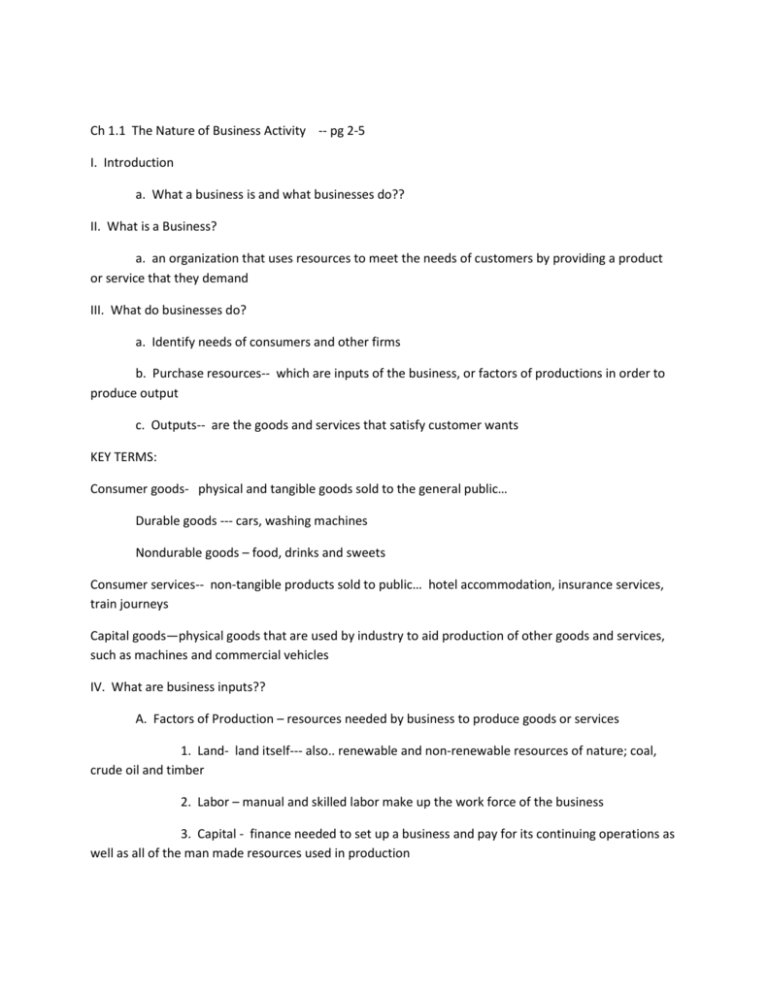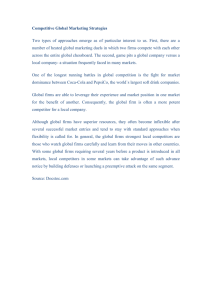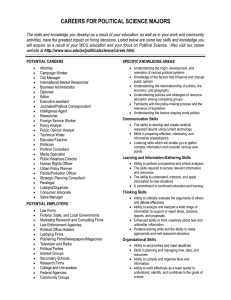Ch 1_1 sample outline notes
advertisement

Ch 1.1 The Nature of Business Activity -- pg 2-5 I. Introduction a. What a business is and what businesses do?? II. What is a Business? a. an organization that uses resources to meet the needs of customers by providing a product or service that they demand III. What do businesses do? a. Identify needs of consumers and other firms b. Purchase resources-- which are inputs of the business, or factors of productions in order to produce output c. Outputs-- are the goods and services that satisfy customer wants KEY TERMS: Consumer goods- physical and tangible goods sold to the general public… Durable goods --- cars, washing machines Nondurable goods – food, drinks and sweets Consumer services-- non-tangible products sold to public… hotel accommodation, insurance services, train journeys Capital goods—physical goods that are used by industry to aid production of other goods and services, such as machines and commercial vehicles IV. What are business inputs?? A. Factors of Production – resources needed by business to produce goods or services 1. Land- land itself--- also.. renewable and non-renewable resources of nature; coal, crude oil and timber 2. Labor – manual and skilled labor make up the work force of the business 3. Capital - finance needed to set up a business and pay for its continuing operations as well as all of the man made resources used in production a. includes – capital goods—computers, machines, factories, offices and vehicles 4. Enterprise-- driving force of business provided by risk-taking individuals—provides a managing, decision making and co-ordinating role. V. Business Functions -- four main functional departments 1. Marketing – a. responsible for market research and analyzing such results so consumer wants can be correctly identified b. make important decisions concerning pricing, how and where to promote it and how to sell it and distribute it for sale 2. Finance -a. monitor the flow of finance into an out of business, keeping and analyzing accounts b. providing information to both senior management and other departments 3. Human Resource Managementa. identifies the workforce needs of the business, recruits, selects and trains appropriate staff and provides motivational systems to help retain staff and encourage them to work productively 4. Operations Management a. responsible for ensuring adequate resources are available for production, maintaining production and quality levels and achieving high levels of productive efficiency Note : Good communication, co-operation and close interrelationships between functions are essential before major decisions are made. Example: Decision by Peugeot Citroen in 2010 to launch world’s first hybrid diesel car required interaction between. Marketing-- will consumers be prepared to buy this car and at what price? Finance – do we have the capital needed to develop and produce it? HR management -- do we need to recruit additional engineers before this project can be turned into a market ready car Operations management -- can we produce this product at a cost which allows the marketing department to set a profitable price level? VI. Sectors of Industry 1. Primary -- firms engaged in farming, fishing, oil extraction, and all other industries that extract natural resources so that they can be used and processed by other firms 2. Secondary -- firms that manufacture and process products from natural resources, including computers, brewing, baking, clothing, construction 3. Tertiary - firms that provide services to consumers and other businesses, such as retailing, transport, insurance, banking, hotels, tourism, and telecommunications. 4. Quarternary Sector??? a. focused on information technology IT – businesses and information service providers











